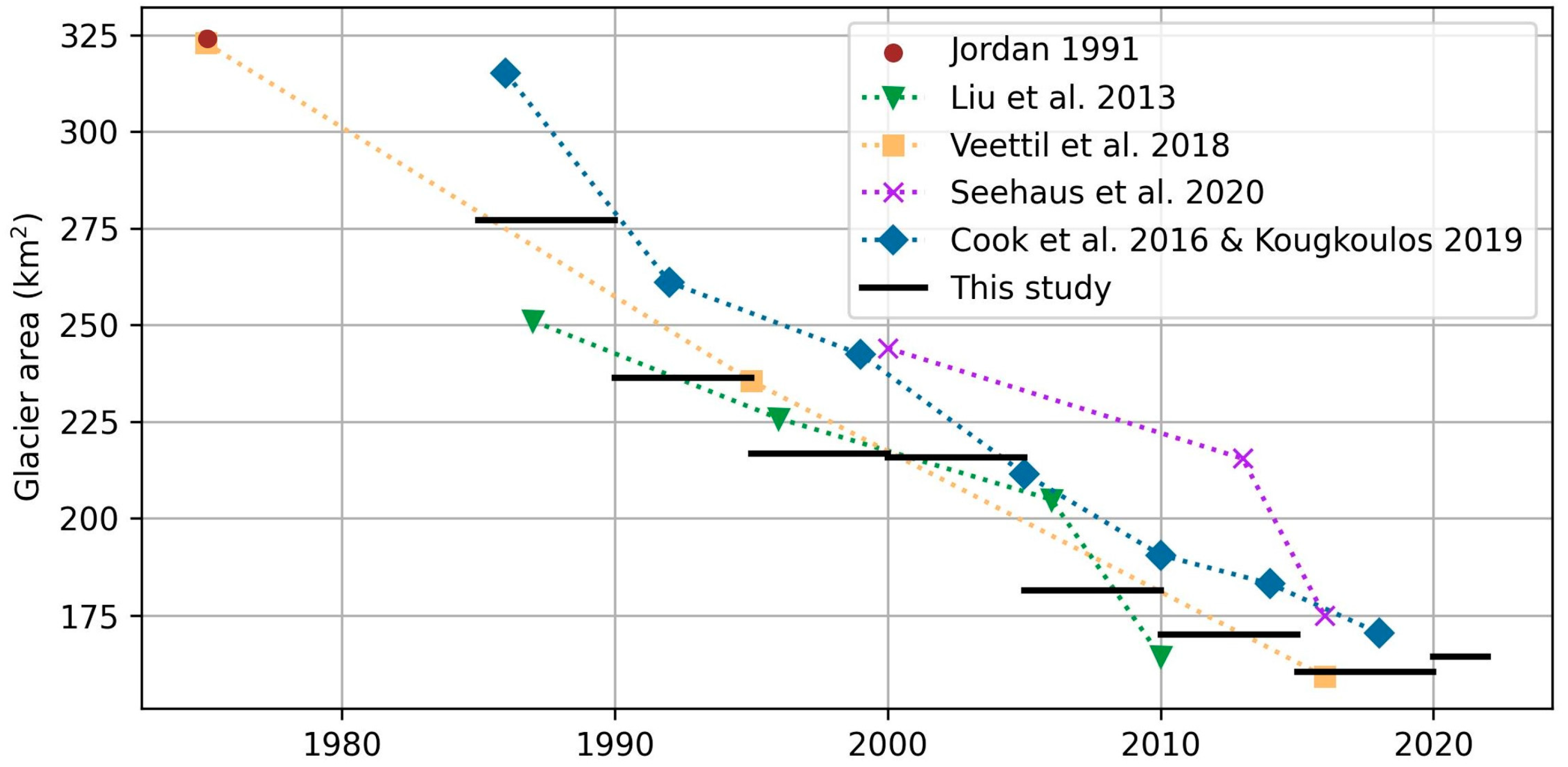Revealing Decadal Glacial Changes and Lake Evolution in the Cordillera Real, Bolivia: A Semi-Automated Landsat Imagery Analysis
Abstract
1. Introduction
2. Materials and Methods
2.1. Study Region
2.2. Data
2.3. Methods
2.3.1. Glacier Mapping
2.3.2. Glacial Lake Inventory
2.3.3. Glacial Lake Delineation
2.3.4. Post Process of Glacial Lake Area Data
2.3.5. Error Estimation
3. Results
3.1. The Area Changes of Glaciers
3.2. Lake Inventory and Its Spatiotemporal Distribution Characteristics
3.3. The Area Change of Lakes in Four Types
4. Discussion
4.1. Temporal Changes of Glaciers and Lakes
4.2. The Impact of Temperature and Precipitation on Glacier and Glacial Lakes
4.3. The Inherent Connection between Glacier Melting and Lake Area under the Changing Climate
4.4. The Potential Influence on Water Resources
5. Conclusions
Author Contributions
Funding
Data Availability Statement
Acknowledgments
Conflicts of Interest
Appendix A
| Date of Image Acquisition | Image ID | Date of Image Acquisition | Image ID |
|---|---|---|---|
| 1988/6/17 | LT05_L1TP_001071_19880617_20200917_02_T1 | 2009/5/26 | LT05_L1TP_001071_20090526_20200827_02_T1 |
| 1988/7/3 | LT05_L1TP_001071_19880703_20200917_02_T1 | 2009/6/11 | LT05_L1TP_001071_20090611_20200827_02_T1 |
| 1988/7/19 | LT05_L1TP_001071_19880719_20200917_02_T1 | 2009/6/27 | LT05_L1TP_001071_20090627_20200827_02_T1 |
| 1988/8/20 | LT05_L1TP_001071_19880820_20200917_02_T1 | 2010/5/13 | LT05_L1TP_001071_20100513_20200824_02_T1 |
| 1991/5/25 | LT05_L1TP_001071_19910525_20230519_02_T1 | 2010/6/14 | LT05_L1TP_001071_20100614_20200824_02_T1 |
| 1992/5/11 | LT05_L1TP_001071_19920511_20200914_02_T1 | 2010/8/17 | LT05_L1TP_001071_20100817_20200824_02_T1 |
| 1992/5/27 | LT05_L1TP_001071_19920527_20200914_02_T1 | 2010/10/4 | LT05_L1TP_001071_20101004_20200823_02_T1 |
| 1992/6/12 | LT05_L1TP_001071_19920612_20200914_02_T1 | 2011/5/16 | LT05_L1TP_001071_20110516_20200822_02_T1 |
| 1994/6/2 | LT05_L1TP_001071_19940602_20200913_02_T1 | 2014/7/11 | LC08_L1TP_001071_20140711_20200911_02_T1 |
| 1994/7/20 | LT05_L1TP_001071_19940720_20200913_02_T1 | 2015/6/28 | LC08_L1TP_001071_20150628_20200909_02_T1 |
| 1995/6/5 | LT05_L1TP_001071_19950605_20200912_02_T1 | 2015/7/30 | LC08_L1TP_001071_20150730_20200908_02_T1 |
| 1995/6/21 | LT05_L1TP_001071_19950621_20200913_02_T1 | 2016/5/29 | LC08_L1TP_001071_20160529_20200906_02_T1 |
| 1995/8/8 | LT05_L1TP_001071_19950808_20200912_02_T1 | 2016/8/1 | LC08_L1TP_001071_20160801_20200906_02_T1 |
| 1996/5/22 | LT05_L1TP_001071_19960522_20200911_02_T1 | 2017/7/19 | LC08_L1TP_001071_20170719_20200903_02_T1 |
| 1999/7/2 | LT05_L1TP_001071_19990702_20200907_02_T1 | 2017/8/4 | LC08_L1TP_001071_20170804_20200903_02_T1 |
| 2000/8/5 | LT05_L1TP_001071_20000805_20200906_02_T1 | 2017/8/20 | LC08_L1TP_001071_20170820_20200903_02_T1 |
| 2003/6/27 | LT05_L1TP_001071_20030627_20200905_02_T1 | 2019/6/7 | LC08_L1TP_001071_20190607_20200828_02_T1 |
| 2004/4/26 | LT05_L1TP_001071_20040426_20200903_02_T1 | 2019/6/23 | LC08_L1TP_001071_20190623_20200827_02_T1 |
| 2004/5/28 | LT05_L1TP_001071_20040528_20200903_02_T1 | 2019/7/9 | LC08_L1TP_001071_20190709_20200827_02_T1 |
| 2005/4/29 | LT05_L1TP_001071_20050429_20200902_02_T1 | 2020/5/24 | LC08_L1TP_001071_20200524_20200820_02_T1 |
| 2005/6/16 | LT05_L1TP_001071_20050616_20200902_02_T1 | 2020/6/9 | LC08_L1TP_001071_20200609_20200824_02_T1 |
| 2005/9/4 | LT05_L1TP_001071_20050904_20200901_02_T1 | 2020/6/25 | LC08_L1TP_001071_20200625_20200823_02_T1 |
| 2006/6/19 | LT05_L1TP_001071_20060619_20200831_02_T1 | 2020/7/11 | LC08_L1TP_001071_20200711_20200912_02_T1 |
| 2006/7/5 | LT05_L1TP_001071_20060705_20200831_02_T1 | 2020/7/27 | LC08_L1TP_001071_20200727_20200908_02_T1 |
| 2008/7/26 | LT05_L1TP_001071_20080726_20200829_02_T1 | 2021/7/14 | LC08_L1TP_001071_20210714_20210721_02_T1 |
| 2008/8/27 | LT05_L1TP_001071_20080827_20200829_02_T1 |
| Date of Image Acquisition | Image ID | Date of Image Acquisition | Image ID |
|---|---|---|---|
| 1984/7/8 | LT05_L1TP_001071_19840708_20200918_02_T1 | 2005/7/18 | LT05_L1TP_001071_20050718_20200902_02_T1 |
| 1986/7/14 | LT05_L1TP_001071_19860714_20200917_02_T1 | 2005/8/3 | LT05_L1TP_001071_20050803_20200902_02_T1 |
| 1986/7/30 | LT05_L1TP_001071_19860730_20200917_02_T1 | 2005/8/19 | LT05_L1TP_001071_20050819_20200902_02_T1 |
| 1986/8/15 | LT05_L1TP_001071_19860815_20200918_02_T1 | 2005/9/4 | LT05_L1TP_001071_20050904_20200901_02_T1 |
| 1986/10/2 | LT05_L1TP_001071_19861002_20200917_02_T1 | 2006/2/27 | LT05_L1TP_001071_20060227_20200901_02_T1 |
| 1987/5/14 | LT05_L1TP_001071_19870514_20201014_02_T1 | 2006/5/2 | LT05_L1TP_001071_20060502_20200901_02_T1 |
| 1987/5/30 | LT05_L1TP_001071_19870530_20201014_02_T1 | 2006/5/18 | LT05_L1TP_001071_20060518_20200901_02_T1 |
| 1987/6/15 | LT05_L1TP_001071_19870615_20201014_02_T1 | 2006/6/3 | LT05_L1TP_001071_20060603_20200831_02_T1 |
| 1987/8/2 | LT05_L1TP_001071_19870802_20201014_02_T1 | 2006/6/19 | LT05_L1TP_001071_20060619_20200831_02_T1 |
| 1987/8/18 | LT05_L1TP_001071_19870818_20201014_02_T1 | 2006/7/5 | LT05_L1TP_001071_20060705_20200831_02_T1 |
| 1987/10/21 | LT05_L1TP_001071_19871021_20201014_02_T1 | 2006/7/21 | LT05_L1TP_001071_20060721_20200831_02_T1 |
| 1988/4/30 | LT05_L1TP_001071_19880430_20200917_02_T1 | 2006/8/6 | LT05_L1TP_001071_20060806_20200831_02_T1 |
| 1988/5/16 | LT05_L1TP_001071_19880516_20200917_02_T1 | 2006/8/22 | LT05_L1TP_001071_20060822_20200831_02_T1 |
| 1988/6/1 | LT05_L1TP_001071_19880601_20200917_02_T1 | 2006/9/23 | LT05_L1TP_001071_20060923_20200831_02_T1 |
| 1988/6/17 | LT05_L1TP_001071_19880617_20200917_02_T1 | 2006/10/9 | LT05_L1TP_001071_20061009_20200831_02_T1 |
| 1988/7/3 | LT05_L1TP_001071_19880703_20200917_02_T1 | 2007/4/19 | LT05_L1TP_001071_20070419_20200830_02_T1 |
| 1988/7/19 | LT05_L1TP_001071_19880719_20200917_02_T1 | 2007/5/5 | LT05_L1TP_001071_20070505_20200830_02_T1 |
| 1988/8/20 | LT05_L1TP_001071_19880820_20200917_02_T1 | 2007/5/21 | LT05_L1TP_001071_20070521_20200830_02_T1 |
| 1988/9/5 | LT05_L1TP_001071_19880905_20200917_02_T1 | 2007/6/22 | LT05_L1TP_001071_20070622_20200830_02_T1 |
| 1988/10/23 | LT05_L1TP_001071_19881023_20200917_02_T1 | 2007/7/24 | LT05_L1TP_001071_20070724_20200829_02_T1 |
| 1989/7/6 | LT05_L1TP_001071_19890706_20200916_02_T1 | 2007/8/25 | LT05_L1TP_001071_20070825_20200829_02_T1 |
| 1989/8/23 | LT05_L1TP_001071_19890823_20200916_02_T1 | 2008/3/20 | LT05_L1TP_001071_20080320_20200829_02_T1 |
| 1989/9/8 | LT05_L1TP_001071_19890908_20200916_02_T1 | 2008/5/7 | LT05_L1TP_001071_20080507_20200829_02_T1 |
| 1990/5/22 | LT05_L1TP_001071_19900522_20200916_02_T1 | 2008/5/23 | LT05_L1TP_001071_20080523_20200829_02_T1 |
| 1990/7/25 | LT05_L1TP_001071_19900725_20200916_02_T1 | 2008/7/26 | LT05_L1TP_001071_20080726_20200829_02_T1 |
| 1990/8/10 | LT05_L1TP_001071_19900810_20200916_02_T1 | 2008/8/11 | LT05_L1TP_001071_20080811_20200829_02_T1 |
| 1990/9/11 | LT05_L1TP_001071_19900911_20200915_02_T1 | 2008/8/27 | LT05_L1TP_001071_20080827_20200829_02_T1 |
| 1991/4/23 | LT05_L1TP_001071_19910423_20230518_02_T1 | 2008/9/28 | LT05_L1TP_001071_20080928_20200829_02_T1 |
| 1991/5/25 | LT05_L1TP_001071_19910525_20230519_02_T1 | 2009/5/26 | LT05_L1TP_001071_20090526_20200827_02_T1 |
| 1991/6/26 | LT05_L1TP_001071_19910626_20230522_02_T1 | 2009/6/11 | LT05_L1TP_001071_20090611_20200827_02_T1 |
| 1991/7/12 | LT05_L1TP_001071_19910712_20230522_02_T1 | 2009/6/27 | LT05_L1TP_001071_20090627_20200827_02_T1 |
| 1991/7/28 | LT05_L1TP_001071_19910728_20200915_02_T1 | 2009/7/29 | LT05_L1TP_001071_20090729_20200827_02_T1 |
| 1991/8/13 | LT05_L1TP_001071_19910813_20230523_02_T1 | 2009/8/30 | LT05_L1TP_001071_20090830_20200825_02_T1 |
| 1991/8/29 | LT05_L1TP_001071_19910829_20200915_02_T1 | 2010/4/11 | LT05_L1TP_001071_20100411_20200824_02_T1 |
| 1991/9/14 | LT05_L1TP_001071_19910914_20230511_02_T1 | 2010/5/13 | LT05_L1TP_001071_20100513_20200824_02_T1 |
| 1991/9/30 | LT05_L1TP_001071_19910930_20230512_02_T1 | 2010/6/14 | LT05_L1TP_001071_20100614_20200824_02_T1 |
| 1992/5/11 | LT05_L1TP_001071_19920511_20200914_02_T1 | 2010/6/30 | LT05_L1TP_001071_20100630_20200823_02_T1 |
| 1992/5/27 | LT05_L1TP_001071_19920527_20200914_02_T1 | 2010/7/16 | LT05_L1TP_001071_20100716_20200824_02_T1 |
| 1992/6/12 | LT05_L1TP_001071_19920612_20200914_02_T1 | 2010/8/17 | LT05_L1TP_001071_20100817_20200824_02_T1 |
| 1992/7/14 | LT05_L1TP_001071_19920714_20200914_02_T1 | 2010/9/18 | LT05_L1TP_001071_20100918_20200823_02_T1 |
| 1992/7/30 | LT05_L1TP_001071_19920730_20200914_02_T1 | 2010/10/4 | LT05_L1TP_001071_20101004_20200823_02_T1 |
| 1992/10/2 | LT05_L1TP_001071_19921002_20200914_02_T1 | 2010/11/5 | LT05_L1TP_001071_20101105_20200823_02_T1 |
| 1992/11/3 | LT05_L1TP_001071_19921103_20200914_02_T1 | 2011/5/16 | LT05_L1TP_001071_20110516_20200822_02_T1 |
| 1992/12/21 | LT05_L1TP_001071_19921221_20200914_02_T1 | 2011/7/19 | LT05_L1TP_001071_20110719_20200822_02_T1 |
| 1993/4/12 | LT05_L1TP_001071_19930412_20200914_02_T1 | 2011/9/5 | LT05_L1TP_001071_20110905_20200820_02_T1 |
| 1993/5/30 | LT05_L1TP_001071_19930530_20200914_02_T1 | 2011/11/8 | LT05_L1TP_001071_20111108_20200820_02_T1 |
| 1993/6/15 | LT05_L1TP_001071_19930615_20200914_02_T1 | 2013/4/19 | LC08_L1TP_001071_20130419_20200913_02_T1 |
| 1993/7/1 | LT05_L1TP_001071_19930701_20200914_02_T1 | 2013/6/22 | LC08_L1TP_001071_20130622_20200912_02_T1 |
| 1993/8/2 | LT05_L1TP_001071_19930802_20200913_02_T1 | 2013/7/24 | LC08_L1TP_001071_20130724_20200912_02_T1 |
| 1993/9/19 | LT05_L1TP_001071_19930919_20200913_02_T1 | 2013/9/26 | LC08_L1TP_001071_20130926_20200913_02_T1 |
| 1994/5/1 | LT05_L1TP_001071_19940501_20200913_02_T1 | 2014/5/8 | LC08_L1TP_001071_20140508_20200911_02_T1 |
| 1994/5/17 | LT05_L1TP_001071_19940517_20200913_02_T1 | 2014/6/9 | LC08_L1TP_001071_20140609_20200911_02_T1 |
| 1994/6/2 | LT05_L1TP_001071_19940602_20200913_02_T1 | 2014/6/25 | LC08_L1TP_001071_20140625_20200911_02_T1 |
| 1994/7/20 | LT05_L1TP_001071_19940720_20200913_02_T1 | 2014/7/11 | LC08_L1TP_001071_20140711_20200911_02_T1 |
| 1994/11/25 | LT05_L1TP_001071_19941125_20200913_02_T1 | 2014/7/27 | LC08_L1TP_001071_20140727_20200911_02_T1 |
| 1995/6/5 | LT05_L1TP_001071_19950605_20200912_02_T1 | 2014/8/28 | LC08_L1TP_001071_20140828_20200911_02_T1 |
| 1995/6/21 | LT05_L1TP_001071_19950621_20200913_02_T1 | 2015/6/12 | LC08_L1TP_001071_20150612_20201015_02_T1 |
| 1995/7/7 | LT05_L1TP_001071_19950707_20200912_02_T1 | 2015/6/28 | LC08_L1TP_001071_20150628_20200909_02_T1 |
| 1995/7/23 | LT05_L1TP_001071_19950723_20200912_02_T1 | 2015/7/14 | LC08_L1TP_001071_20150714_20200908_02_T1 |
| 1995/8/8 | LT05_L1TP_001071_19950808_20200912_02_T1 | 2015/7/30 | LC08_L1TP_001071_20150730_20200908_02_T1 |
| 1996/4/20 | LT05_L1TP_001071_19960420_20200911_02_T1 | 2015/11/19 | LC08_L1TP_001071_20151119_20200908_02_T1 |
| 1996/5/6 | LT05_L1TP_001071_19960506_20200911_02_T1 | 2016/1/22 | LC08_L1TP_001071_20160122_20200907_02_T1 |
| 1996/5/22 | LT05_L1TP_001071_19960522_20200911_02_T1 | 2016/4/27 | LC08_L1TP_001071_20160427_20200907_02_T1 |
| 1996/7/25 | LT05_L1TP_001071_19960725_20200911_02_T1 | 2016/5/29 | LC08_L1TP_001071_20160529_20200906_02_T1 |
| 1996/8/10 | LT05_L1TP_001071_19960810_20200911_02_T1 | 2016/6/14 | LC08_L1TP_001071_20160614_20200906_02_T1 |
| 1997/5/9 | LT05_L1TP_001071_19970509_20200910_02_T1 | 2016/6/30 | LC08_L1TP_001071_20160630_20200906_02_T1 |
| 1997/5/25 | LT05_L1TP_001071_19970525_20200910_02_T1 | 2016/7/16 | LC08_L1TP_001071_20160716_20200906_02_T1 |
| 1997/6/10 | LT05_L1TP_001071_19970610_20200910_02_T1 | 2016/8/1 | LC08_L1TP_001071_20160801_20200906_02_T1 |
| 1997/7/12 | LT05_L1TP_001071_19970712_20200910_02_T1 | 2016/8/17 | LC08_L1TP_001071_20160817_20200906_02_T1 |
| 1997/8/29 | LT05_L1TP_001071_19970829_20200909_02_T1 | 2016/9/18 | LC08_L1TP_001071_20160918_20200906_02_T1 |
| 1998/5/12 | LT05_L1TP_001071_19980512_20200909_02_T1 | 2017/2/9 | LC08_L1TP_001071_20170209_20200905_02_T1 |
| 1998/6/13 | LT05_L1TP_001071_19980613_20200909_02_T1 | 2017/4/14 | LC08_L1TP_001071_20170414_20200904_02_T1 |
| 1998/7/15 | LT05_L1TP_001071_19980715_20200908_02_T1 | 2017/6/1 | LC08_L1TP_001071_20170601_20200903_02_T1 |
| 1998/7/31 | LT05_L1TP_001071_19980731_20200908_02_T1 | 2017/6/17 | LC08_L1TP_001071_20170617_20200903_02_T1 |
| 1998/9/17 | LT05_L1TP_001071_19980917_20200908_02_T1 | 2017/7/19 | LC08_L1TP_001071_20170719_20200903_02_T1 |
| 1999/5/15 | LT05_L1TP_001071_19990515_20200908_02_T1 | 2017/8/4 | LC08_L1TP_001071_20170804_20200903_02_T1 |
| 1999/7/2 | LT05_L1TP_001071_19990702_20200907_02_T1 | 2017/8/20 | LC08_L1TP_001071_20170820_20200903_02_T1 |
| 1999/8/19 | LT05_L1TP_001071_19990819_20200907_02_T1 | 2017/11/8 | LC08_L1TP_001071_20171108_20200902_02_T1 |
| 2000/5/1 | LT05_L1TP_001071_20000501_20200907_02_T1 | 2017/11/24 | LC08_L1TP_001071_20171124_20200902_02_T1 |
| 2000/7/4 | LT05_L1TP_001071_20000704_20200907_02_T1 | 2018/4/17 | LC08_L1TP_001071_20180417_20201015_02_T1 |
| 2000/8/5 | LT05_L1TP_001071_20000805_20200906_02_T1 | 2018/5/19 | LC08_L1TP_001071_20180519_20200901_02_T1 |
| 2001/4/18 | LT05_L1TP_001071_20010418_20200906_02_T1 | 2018/6/20 | LC08_L1TP_001071_20180620_20201015_02_T1 |
| 2001/6/5 | LT05_L1TP_001071_20010605_20200906_02_T1 | 2018/7/6 | LC08_L1TP_001071_20180706_20200831_02_T1 |
| 2001/6/21 | LT05_L1TP_001071_20010621_20230211_02_T1 | 2018/7/22 | LC08_L1TP_001071_20180722_20200831_02_T1 |
| 2001/7/23 | LT05_L1TP_001071_20010723_20200906_02_T1 | 2018/8/23 | LC08_L1TP_001071_20180823_20200831_02_T1 |
| 2001/8/24 | LT05_L1TP_001071_20010824_20200905_02_T1 | 2018/9/8 | LC08_L1TP_001071_20180908_20200831_02_T1 |
| 2001/9/9 | LT05_L1TP_001071_20010909_20200905_02_T1 | 2019/6/7 | LC08_L1TP_001071_20190607_20200828_02_T1 |
| 2001/9/25 | LT05_L1TP_001071_20010925_20200905_02_T1 | 2019/6/23 | LC08_L1TP_001071_20190623_20200827_02_T1 |
| 2003/6/27 | LT05_L1TP_001071_20030627_20200905_02_T1 | 2019/7/9 | LC08_L1TP_001071_20190709_20200827_02_T1 |
| 2003/7/13 | LT05_L1TP_001071_20030713_20200904_02_T1 | 2019/7/25 | LC08_L1TP_001071_20190725_20200827_02_T1 |
| 2003/8/14 | LT05_L1TP_001071_20030814_20200904_02_T1 | 2019/8/26 | LC08_L1TP_001071_20190826_20200826_02_T1 |
| 2003/8/30 | LT05_L1TP_001071_20030830_20200904_02_T1 | 2019/9/27 | LC08_L1TP_001071_20190927_20200825_02_T1 |
| 2003/10/17 | LT05_L1TP_001071_20031017_20200904_02_T1 | 2020/5/8 | LC08_L1TP_001071_20200508_20200820_02_T1 |
| 2003/11/18 | LT05_L1TP_001071_20031118_20200904_02_T1 | 2020/5/24 | LC08_L1TP_001071_20200524_20200820_02_T1 |
| 2004/4/26 | LT05_L1TP_001071_20040426_20200903_02_T1 | 2020/6/9 | LC08_L1TP_001071_20200609_20200824_02_T1 |
| 2004/5/12 | LT05_L1TP_001071_20040512_20200903_02_T1 | 2020/6/25 | LC08_L1TP_001071_20200625_20200823_02_T1 |
| 2004/5/28 | LT05_L1TP_001071_20040528_20200903_02_T1 | 2020/7/11 | LC08_L1TP_001071_20200711_20200912_02_T1 |
| 2004/6/13 | LT05_L1TP_001071_20040613_20200903_02_T1 | 2020/7/27 | LC08_L1TP_001071_20200727_20200908_02_T1 |
| 2004/6/29 | LT05_L1TP_001071_20040629_20200903_02_T1 | 2020/8/28 | LC08_L1TP_001071_20200828_20200906_02_T1 |
| 2004/7/15 | LT05_L1TP_001071_20040715_20200903_02_T1 | 2021/5/11 | LC08_L1TP_001071_20210511_20210524_02_T1 |
| 2004/9/17 | LT05_L1TP_001071_20040917_20200903_02_T1 | 2021/6/12 | LC08_L1TP_001071_20210612_20210622_02_T1 |
| 2004/10/3 | LT05_L1TP_001071_20041003_20200903_02_T1 | 2021/7/14 | LC08_L1TP_001071_20210714_20210721_02_T1 |
| 2005/4/29 | LT05_L1TP_001071_20050429_20200902_02_T1 | 2021/7/30 | LC08_L1TP_001071_20210730_20210804_02_T1 |
| 2005/5/15 | LT05_L1TP_001071_20050515_20230211_02_T1 | 2021/8/15 | LC08_L1TP_001071_20210815_20210826_02_T1 |
| 2005/5/31 | LT05_L1TP_001071_20050531_20200902_02_T1 | 2021/8/31 | LC08_L1TP_001071_20210831_20210909_02_T1 |
| 2005/6/16 | LT05_L1TP_001071_20050616_20200902_02_T1 | 2021/10/18 | LC08_L1TP_001071_20211018_20211026_02_T1 |
| 2005/7/2 | LT05_L1TP_001071_20050702_20200902_02_T1 |
| Date of Image Acquisition | Image ID |
|---|---|
| 2016/4/27 | S2A_MSIL1C_20160427T145722_N0201_R139_T19LEC_20160427T145719 |
| 2016/7/16 | S2A_MSIL1C_20160716T144732_N0204_R139_T19LEC_20160716T145212 |
| 2017/6/1 | S2A_MSIL1C_20170601T144731_N0205_R139_T19LEC_20170601T144737 |
| 2017/8/20 | S2A_MSIL1C_20170820T144731_N0205_R139_T19LEC_20170820T145633 |
| 2017/11/8 | S2A_MSIL1C_20171108T144731_N0206_R139_T19LEC_20171108T181232 |
| 2018/4/17 | S2A_MSIL1C_20180417T144731_N0206_R139_T19LEC_20180417T200318 |
| 2018/7/6 | S2A_MSIL1C_20180706T144731_N0206_R139_T19LEC_20180706T181524 |
| 2020/6/25 | S2A_MSIL1C_20200625T144731_N0209_R139_T19LEC_20200625T181113 |
| 2021/5/11 | S2A_MSIL1C_20210511T144731_N0300_R139_T19LEC_20210512T140023 |
| 2021/7/30 | S2A_MSIL1C_20210730T144731_N0301_R139_T19LEC_20210730T181642 |
| 2021/10/18 | S2A_MSIL1C_20211018T144731_N0301_R139_T19LEC_20211018T181804 |
Appendix B

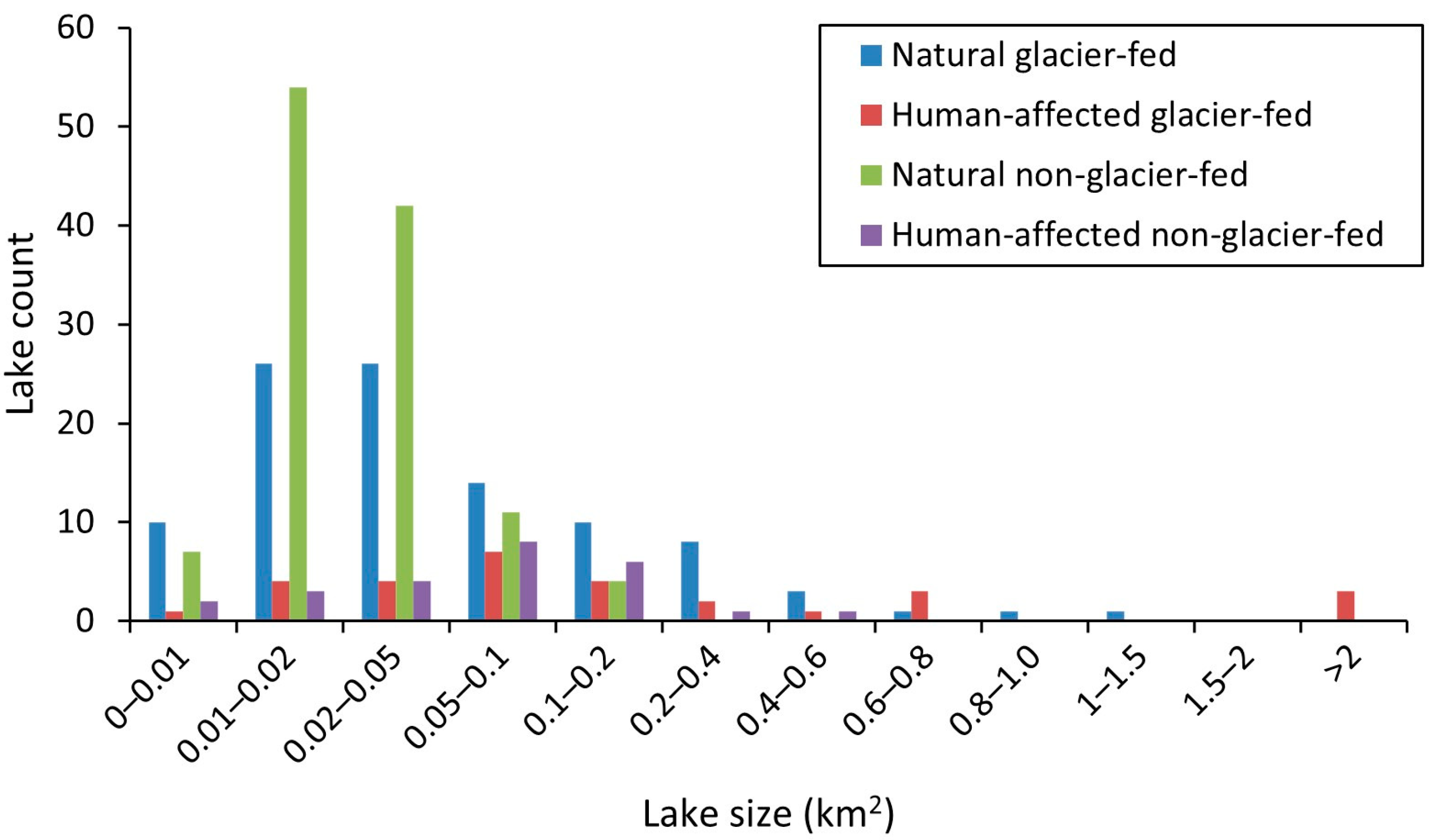
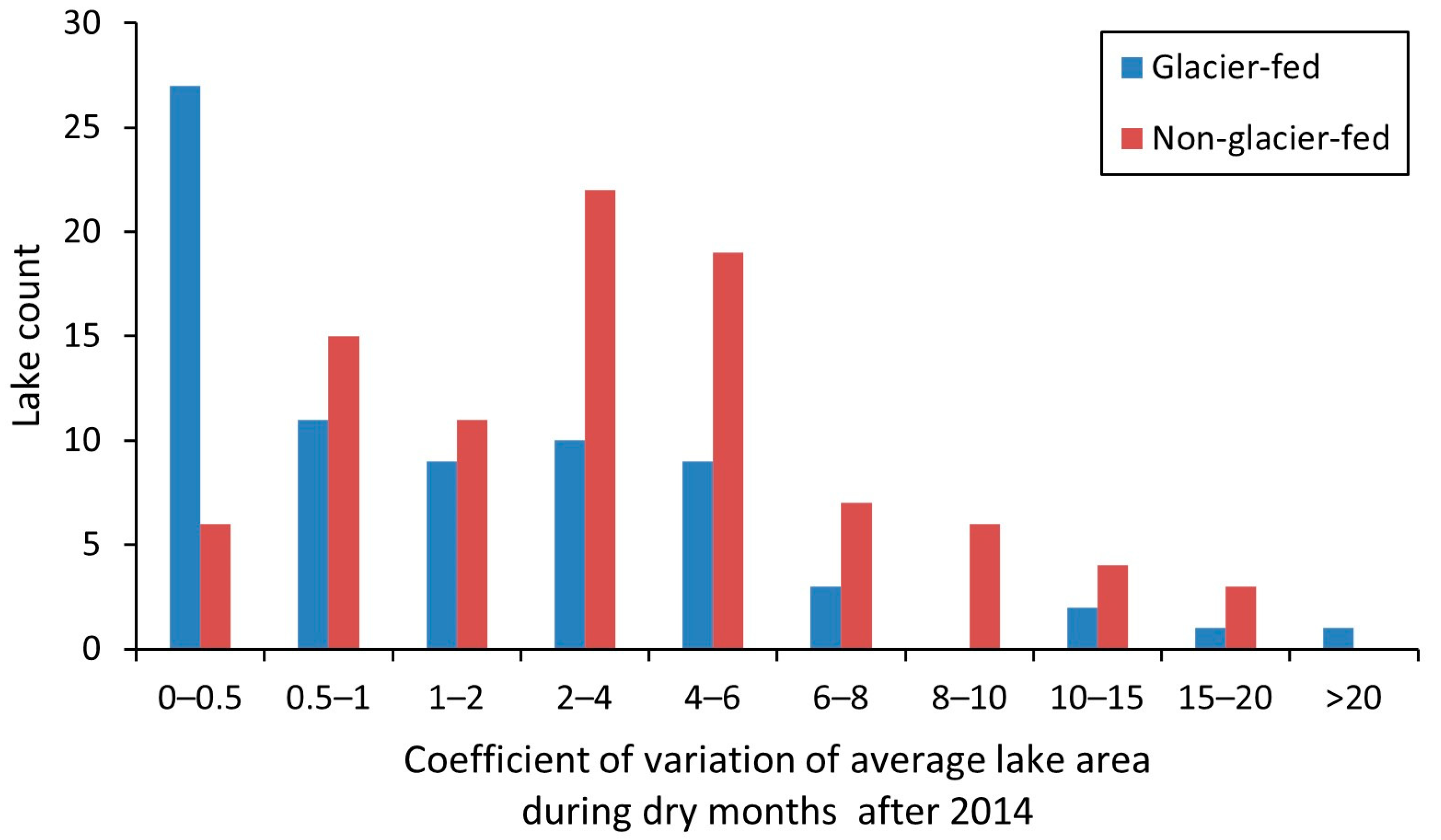
Appendix C
| Full Name | Abbreviate | Domain | Resolution | Parameters | Data Types | Meteorological Inputs * | Institutional Sources | Data Access | ||
|---|---|---|---|---|---|---|---|---|---|---|
| Spatial | Temporal | Spatial | Temporal | |||||||
| ECMWF Reanalysis 5 | ERA5 | Global | 1979–2020 | 0.25° | Monthly | Temperature, precipitation | Reanalysis | - | ECMWF/Copernicus Climate Change Service | https://developers.google.com/earth-engine/datasets/catalog/ECMWF_ERA5_MONTHLY, accessed on 13 June 2023 |
| ECMWF Reanalysis 5-Land | ERA5-Land | Global | 1981–present | 0.1° | Monthly | Temperature, precipitation | Reanalysis | - | Google and Copernicus Climate Data Store | https://developers.google.com/earth-engine/datasets/catalog/ECMWF_ERA5_LAND_MONTHLY_AGGR, accessed on 13 June 2023 |
| Climate Hazards group Infrared Precipitation with Stations (Version 2.0 Final) | CHIRPS | 50°S–50°N | 1981–present | 0.05° | Daily | Precipitation | Satellite | - | Climate Hazards Center UC SANTA BARBARA | https://chc.ucsb.edu/data/chirps, accessed on 12 July 2023 |
| Famine Early Warning Systems Network (FEWS NET) Land Data Assimilation System | FLDAS | 60°S–90°N | 1982–present | 0.1° | Monthly | Temperature, precipitation | Reanalysis | MERRA-2 & CHIRPS | NASA GES DISC at NASA Goddard Space Flight Center | https://developers.google.com/earth-engine/datasets/catalog/NASA_FLDAS_NOAH01_C_GL_M_V001, accessed on 13 June 2023 |
| Tropical Rainfall Measuring Mission 3B43 | TRMM 3B43 | 50°S–50°N | 1998–2019 | 0.25° | Monthly | Precipitation | Satellite | - | NASA GES DISC at NASA Goddard Space Flight Center | https://developers.google.com/earth-engine/datasets/catalog/TRMM_3B43V7, accessed on 13 June 2023 |
| Global Precipitation Measurement v6 | GPM | Global | 2000–2021 | 0.1° | Monthly | Precipitation | Satellite | - | NASA GES DISC at NASA Goddard Space Flight Center | https://developers.google.com/earth-engine/datasets/catalog/NASA_GPM_L3_IMERG_MONTHLY_V06, accessed on 13 June 2023 |
| Global Land Data Assimilation System Noah Land Surface Model L4 V2.1 | GLDAS Noah | 60°S–90°N | 2000–present | 0.25° | Monthly | Temperature, precipitation | Reanalysis | GDAS, GPCP, & AGRMET | Goddard Earth Sciences Data and Information Services Center (GES DISC) | https://disc.gsfc.nasa.gov/datasets/GLDAS_NOAH025_M_2.1/summary, accessed on 13 June 2023 |
| NSE | RSR | PBIAS | |
|---|---|---|---|
| Temperature | |||
| ERA5-Land | 0.815 | 0.430 | −0.106 |
| FLDAS | 0.821 | 0.423 | −0.052 |
| Precipitation | |||
| ERA5 | −0.340 | 1.157 | −68.747 |
| ERA5-Land | −0.424 | 1.193 | −72.092 |
| CHIRPS | 0.651 | 0.590 | 11.020 |
| FLDAS | 0.648 | 0.593 | 18.569 |
| TRMM | 0.872 | 0.358 | 5.341 |
| GPM | 0.498 | 0.708 | 38.647 |
| GLDAS Noah | 0.674 | 0.571 | 6.769 |
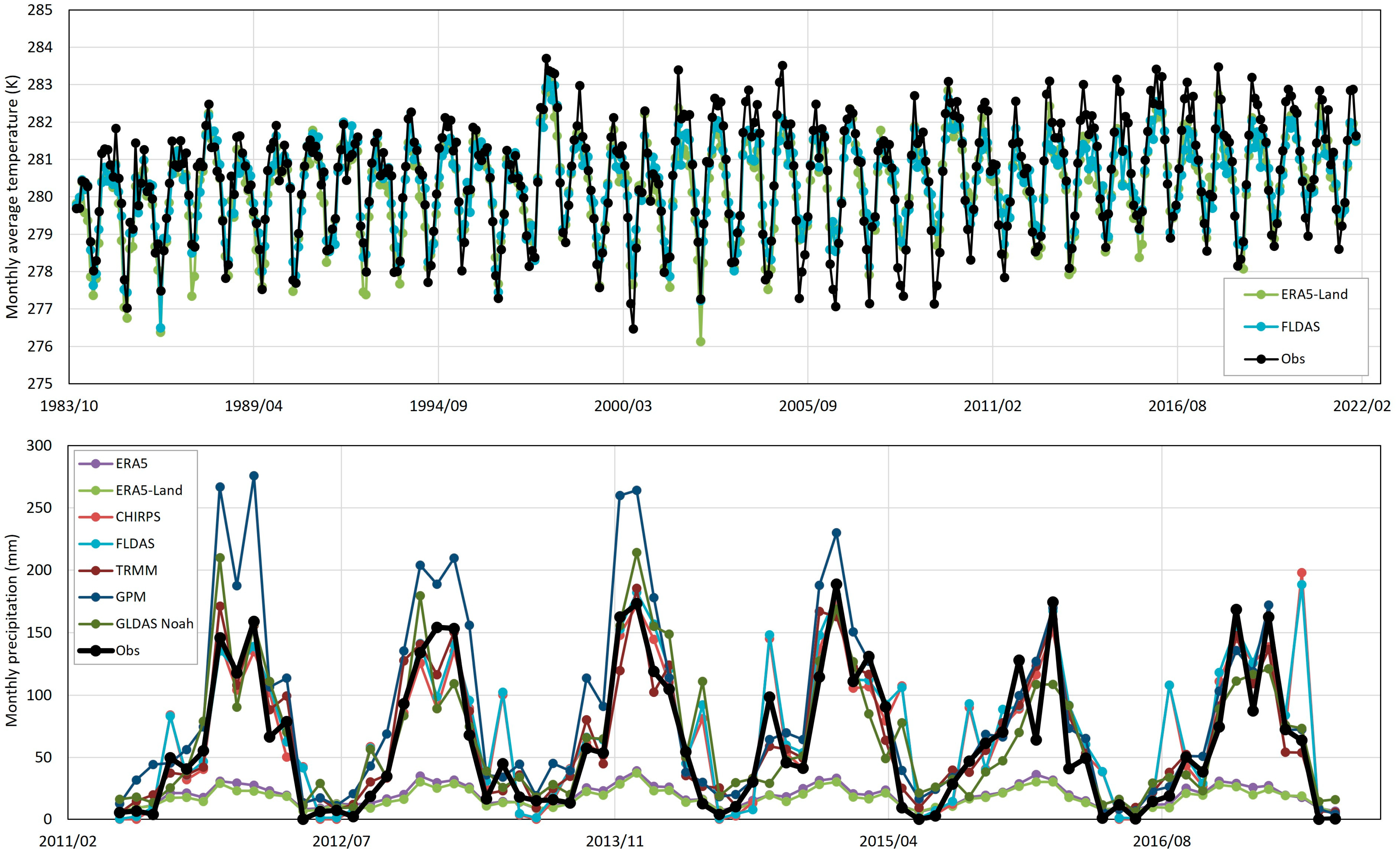
References
- Immerzeel, W.W.; Van Beek, L.P.H.; Bierkens, M.F.P. Climate Change Will Affect the Asian Water Towers. Science 2010, 328, 1382–1385. [Google Scholar] [CrossRef] [PubMed]
- Vergara, W.; Deeb, A.; Valencia, A.; Bradley, R.; Francou, B.; Zarzar, A.; Grünwaldt, A.; Haeussling, S. Economic Impacts of Rapid Glacier Retreat in the Andes. EoS Trans. 2007, 88, 261–264. [Google Scholar] [CrossRef]
- Kaser, G. A Review of the Modern Fluctuations of Tropical Glaciers. Glob. Planet. Change 1999, 22, 93–103. [Google Scholar] [CrossRef]
- Zemp, M.; Huss, M.; Thibert, E.; Eckert, N.; McNabb, R.; Huber, J.; Barandun, M.; Machguth, H.; Nussbaumer, S.U.; Gärtner-Roer, I.; et al. Global Glacier Mass Changes and Their Contributions to Sea-Level Rise from 1961 to 2016. Nature 2019, 568, 382–386. [Google Scholar] [CrossRef] [PubMed]
- Bradley, R.S.; Vuille, M.; Diaz, H.F.; Vergara, W. Threats to Water Supplies in the Tropical Andes. Science 2006, 312, 1755–1756. [Google Scholar] [CrossRef] [PubMed]
- Rabatel, A.; Francou, B.; Soruco, A.; Gomez, J.; Cáceres, B.; Ceballos, J.L.; Basantes, R.; Vuille, M.; Sicart, J.-E.; Huggel, C.; et al. Current State of Glaciers in the Tropical Andes: A Multi-Century Perspective on Glacier Evolution and Climate Change. Cryosphere 2013, 7, 81–102. [Google Scholar] [CrossRef]
- Cook, S.J.; Kougkoulos, I.; Edwards, L.A.; Dortch, J.; Hoffmann, D. Glacier Change and Glacial Lake Outburst Flood Risk in the Bolivian Andes. Cryosphere 2016, 10, 2399–2413. [Google Scholar] [CrossRef]
- Carey, M. Living and Dying with Glaciers: People’s Historical Vulnerability to Avalanches and Outburst Floods in Peru. Glob. Planet. Change 2005, 47, 122–134. [Google Scholar] [CrossRef]
- Dussaillant, I.; Berthier, E.; Brun, F.; Masiokas, M.; Hugonnet, R.; Favier, V.; Rabatel, A.; Pitte, P.; Ruiz, L. Two Decades of Glacier Mass Loss along the Andes. Nat. Geosci. 2019, 12, 802–808. [Google Scholar] [CrossRef]
- Kinouchi, T.; Nakajima, T.; Mendoza, J.; Fuchs, P.; Asaoka, Y. Water Security in High Mountain Cities of the Andes under a Growing Population and Climate Change: A Case Study of La Paz and El Alto, Bolivia. Water Secur. 2019, 6, 100025. [Google Scholar] [CrossRef]
- Kougkoulos, I. Glacial Lake Outburst Flood Risk in the Bolivian Andes. Ph.D. Dissertation, Manchester Metropolitan University, Manchester, UK, 2019. [Google Scholar]
- Liu, T.; Kinouchi, T.; Ledezma, F. Characterization of Recent Glacier Decline in the Cordillera Real by LANDSAT, ALOS, and ASTER Data. Remote Sens. Environ. 2013, 137, 158–172. [Google Scholar] [CrossRef]
- Seehaus, T.; Malz, P.; Sommer, C.; Soruco, A.; Rabatel, A.; Braun, M. Mass Balance and Area Changes of Glaciers in the Cordillera Real and Tres Cruces, Bolivia, between 2000 and 2016. J. Glaciol. 2020, 66, 124–136. [Google Scholar] [CrossRef]
- Sicart, J.E.; Hock, R.; Ribstein, P.; Litt, M.; Ramirez, E. Analysis of Seasonal Variations in Mass Balance and Meltwater Discharge of the Tropical Zongo Glacier by Application of a Distributed Energy Balance Model. J. Geophys. Res. 2011, 116, D13105. [Google Scholar] [CrossRef]
- Soruco, A.; Vincent, C.; Francou, B.; Gonzalez, J.F. Glacier Decline between 1963 and 2006 in the Cordillera Real, Bolivia. Geophys. Res. Lett. 2009, 36, 2008GL036238. [Google Scholar] [CrossRef]
- Veettil, B.K.; Wang, S.; Simões, J.C.; Pereira, S.F.R. Glacier Monitoring in the Eastern Mountain Ranges of Bolivia from 1975 to 2016 Using Landsat and Sentinel-2 Data. Environ. Earth Sci. 2018, 77, 452. [Google Scholar] [CrossRef]
- Veettil, B.K.; Kamp, U. Glacial Lakes in the Andes under a Changing Climate: A Review. J. Earth Sci. 2021, 32, 1575–1593. [Google Scholar] [CrossRef]
- Vuille, M.; Carey, M.; Huggel, C.; Buytaert, W.; Rabatel, A.; Jacobsen, D.; Soruco, A.; Villacis, M.; Yarleque, C.; Elison Timm, O.; et al. Rapid Decline of Snow and Ice in the Tropical Andes—Impacts, Uncertainties and Challenges Ahead. Earth Sci. Rev. 2018, 176, 195–213. [Google Scholar] [CrossRef]
- Drenkhan, F.; Guardamino, L.; Huggel, C.; Frey, H. Current and Future Glacier and Lake Assessment in the Deglaciating Vilcanota-Urubamba Basin, Peruvian Andes. Glob. Planet. Change 2018, 169, 105–118. [Google Scholar] [CrossRef]
- Song, C.; Sheng, Y. Contrasting Evolution Patterns between Glacier-Fed and Non-Glacier-Fed Lakes in the Tanggula Mountains and Climate Cause Analysis. Clim. Change 2016, 135, 493–507. [Google Scholar] [CrossRef]
- Paul, F.; Kääb, A.; Maisch, M.; Kellenberger, T.; Haeberli, W. The New Remote-Sensing-Derived Swiss Glacier Inventory: I. Methods. Ann. Glaciol. 2002, 34, 355–361. [Google Scholar] [CrossRef]
- Hall, D.K.; Riggs, G.A.; Salomonson, V.V.; DiGirolamo, N.E.; Bayr, K.J. MODIS Snow-Cover Products. Remote Sens. Environ. 2002, 83, 181–194. [Google Scholar] [CrossRef]
- McFEETERS, S.K. The Use of the Normalized Difference Water Index (NDWI) in the Delineation of Open Water Features. Int. J. Remote Sens. 1996, 17, 1425–1432. [Google Scholar] [CrossRef]
- Pekel, J.-F.; Cottam, A.; Gorelick, N.; Belward, A.S. High-Resolution Mapping of Global Surface Water and Its Long-Term Changes. Nature 2016, 540, 418–422. [Google Scholar] [CrossRef] [PubMed]
- Veh, G.; Korup, O.; Roessner, S.; Walz, A. Detecting Himalayan Glacial Lake Outburst Floods from Landsat Time Series. Remote Sens. Environ. 2018, 207, 84–97. [Google Scholar] [CrossRef]
- Zhao, H.; Chen, F.; Zhang, M. A Systematic Extraction Approach for Mapping Glacial Lakes in High Mountain Regions of Asia. IEEE J. Sel. Top. Appl. Earth Obs. Remote Sens. 2018, 11, 2788–2799. [Google Scholar] [CrossRef]
- Paul, F.; Rastner, P. Glacier Extents in Peru and Bolivia Are Overestimated in RGIv6 by 27%. In Proceedings of the EGU General Assembly 2023, Vienna, Austria, 24–28 April 2023. EGU23-12724. [Google Scholar] [CrossRef]
- Jordan, E. Die Gletscher der Bolivianischen Anden: Eine Photogrammetrisch-Kartographische Bestandsaufnahme der Gletscher Boliviens Als Grundlage für Klimatische Deutungen und Potential für die Wirtschaftliche Nutzung; Steiner: Stuttgart, Germany, 1991; ISBN 978-3-515-04917-7. [Google Scholar]
- Rabatel, A.; Jomelli, V.; Naveau, P.; Francou, B.; Grancher, D. Dating of Little Ice Age Glacier Fluctuations in the Tropical Andes: Charquini Glaciers, Bolivia, 16°S. Comptes Rendus. Géoscience 2005, 337, 1311–1322. [Google Scholar] [CrossRef]
- Raup, B.; Racoviteanu, A.; Khalsa, S.J.S.; Helm, C.; Armstrong, R.; Arnaud, Y. The GLIMS Geospatial Glacier Database: A New Tool for Studying Glacier Change. Glob. Planet. Change 2007, 56, 101–110. [Google Scholar] [CrossRef]
- Jomelli, V.; Favier, V.; Rabatel, A.; Brunstein, D.; Hoffmann, G.; Francou, B. Fluctuations of Glaciers in the Tropical Andes over the Last Millennium and Palaeoclimatic Implications: A Review. Palaeogeogr. Palaeoclimatol. Palaeoecol. 2009, 281, 269–282. [Google Scholar] [CrossRef]
- Rabatel, A.; Bermejo, A.; Loarte, E.; Soruco, A.; Gomez, J.; Leonardini, G.; Vincent, C.; Sicart, J.E. Can the Snowline Be Used as an Indicator of the Equilibrium Line and Mass Balance for Glaciers in the Outer Tropics? J. Glaciol. 2012, 58, 1027–1036. [Google Scholar] [CrossRef]
- Yao, X.; Liu, S.; Han, L.; Sun, M.; Zhao, L. Definition and Classification System of Glacial Lake for Inventory and Hazards Study. J. Geogr. Sci. 2018, 28, 193–205. [Google Scholar] [CrossRef]
- Foga, S.; Scaramuzza, P.L.; Guo, S.; Zhu, Z.; Dilley, R.D.; Beckmann, T.; Schmidt, G.L.; Dwyer, J.L.; Joseph Hughes, M.; Laue, B. Cloud Detection Algorithm Comparison and Validation for Operational Landsat Data Products. Remote Sens. Environ. 2017, 194, 379–390. [Google Scholar] [CrossRef]
- Farr, T.G.; Rosen, P.A.; Caro, E.; Crippen, R.; Duren, R.; Hensley, S.; Kobrick, M.; Paller, M.; Rodriguez, E.; Roth, L.; et al. The Shuttle Radar Topography Mission. Rev. Geophys. 2007, 45, 2005RG000183. [Google Scholar] [CrossRef]
- Alvizuri-Tintaya, P.A.; Rios-Ruiz, M.; Lora-Garcia, J.; Torregrosa-López, J.I.; Lo-Iacono-Ferreira, V.G. Study and Evaluation of Surface Water Resources Affected by Ancient and Illegal Mining in the Upper Part of the Milluni Micro-Basin, Bolivia. Resources 2022, 11, 36. [Google Scholar] [CrossRef]
- Caballero, Y.; Chevallier, P.; Gallaire, R.; Pillco, R. Flow Modelling in a High Mountain Valley Equipped with Hydropower Plants: Rio Zongo Valley, Cordillera Real, Bolivia. Hydrol. Process. 2004, 18, 939–957. [Google Scholar] [CrossRef]
- Otsu, N. A Threshold Selection Method from Gray-Level Histograms. IEEE Trans. Syst. Man Cybern. 1979, 9, 62–66. [Google Scholar] [CrossRef]
- Mölg, N.; Bolch, T.; Rastner, P.; Strozzi, T.; Paul, F. A Consistent Glacier Inventory for Karakoram and Pamir Derived from Landsat Data: Distribution of Debris Cover and Mapping Challenges. Earth Syst. Sci. Data 2018, 10, 1807–1827. [Google Scholar] [CrossRef]
- Paul, F.; Andreassen, L.M.; Winsvold, S.H. A New Glacier Inventory for the Jostedalsbreen Region, Norway, from Landsat TM Scenes of 2006 and Changes since 1966. Ann. Glaciol. 2011, 52, 153–162. [Google Scholar] [CrossRef]
- Bolch, T.; Menounos, B.; Wheate, R. Landsat-Based Inventory of Glaciers in Western Canada, 1985–2005. Remote Sens. Environ. 2010, 114, 127–137. [Google Scholar] [CrossRef]
- Wang, X.; Guo, X.; Yang, C.; Liu, Q.; Wei, J.; Zhang, Y.; Liu, S.; Zhang, Y.; Jiang, Z.; Tang, Z. Glacial Lake Inventory of High-Mountain Asia in 1990 and 2018 Derived from Landsat Images. Earth Syst. Sci. Data 2020, 12, 2169–2182. [Google Scholar] [CrossRef]
- Jiang, S.; Nie, Y.; Liu, Q.; Wang, J.; Liu, L.; Hassan, J.; Liu, X.; Xu, X. Glacier Change, Supraglacial Debris Expansion and Glacial Lake Evolution in the Gyirong River Basin, Central Himalayas, between 1988 and 2015. Remote Sens. 2018, 10, 986. [Google Scholar] [CrossRef]
- Li, J.; Sheng, Y. An Automated Scheme for Glacial Lake Dynamics Mapping Using Landsat Imagery and Digital Elevation Models: A Case Study in the Himalayas. Int. J. Remote Sens. 2012, 33, 5194–5213. [Google Scholar] [CrossRef]
- Achanta, R.; Susstrunk, S. Superpixels and Polygons Using Simple Non-Iterative Clustering. In Proceedings of the 2017 IEEE Conference on Computer Vision and Pattern Recognition (CVPR), Honolulu, HI, USA, 21–26 July 2017; pp. 4895–4904. [Google Scholar]
- Shugar, D.H.; Burr, A.; Haritashya, U.K.; Kargel, J.S.; Watson, C.S.; Kennedy, M.C.; Bevington, A.R.; Betts, R.A.; Harrison, S.; Strattman, K. Rapid Worldwide Growth of Glacial Lakes since 1990. Nat. Clim. Change 2020, 10, 939–945. [Google Scholar] [CrossRef]
- Mitkari, K.V.; Arora, M.K.; Tiwari, R.K. Extraction of Glacial Lakes in Gangotri Glacier Using Object-Based Image Analysis. IEEE J. Sel. Top. Appl. Earth Obs. Remote Sens. 2017, 10, 5275–5283. [Google Scholar] [CrossRef]
- Nie, Y.; Sheng, Y.; Liu, Q.; Liu, L.; Liu, S.; Zhang, Y.; Song, C. A Regional-Scale Assessment of Himalayan Glacial Lake Changes Using Satellite Observations from 1990 to 2015. Remote Sens. Environ. 2017, 189, 1–13. [Google Scholar] [CrossRef]
- Vincent, L.; Soille, P. Watersheds in Digital Spaces: An Efficient Algorithm Based on Immersion Simulations. IEEE Trans. Pattern Anal. Mach. Intell. 1991, 13, 583–598. [Google Scholar] [CrossRef]
- Hanshaw, M.N.; Bookhagen, B. Glacial Areas, Lake Areas, and Snow Lines from 1975 to 2012: Status of the Cordillera Vilcanota, Including the Quelccaya Ice Cap, Northern Central Andes, Peru. Cryosphere 2014, 8, 359–376. [Google Scholar] [CrossRef]
- Jawak, S.D.; Luis, A.J. A Semiautomatic Extraction of Antarctic Lake Features Using Worldview-2 Imagery. Photogramm. Eng. Remote Sens. 2014, 80, 939–952. [Google Scholar] [CrossRef]
- Vuille, M.; Francou, B.; Wagnon, P.; Juen, I.; Kaser, G.; Mark, B.G.; Bradley, R.S. Climate Change and Tropical Andean Glaciers: Past, Present and Future. Earth-Sci. Rev. 2008, 89, 79–96. [Google Scholar] [CrossRef]
- Yarleque, C.; Vuille, M.; Hardy, D.R.; Timm, O.E.; De La Cruz, J.; Ramos, H.; Rabatel, A. Projections of the Future Disappearance of the Quelccaya Ice Cap in the Central Andes. Sci. Rep. 2018, 8, 15564. [Google Scholar] [CrossRef]
- Lejeune, Y. Apports Des Modèles de Neige CROCUS et de Sol ISBA à l’étude Du Bilan Glaciologique d’un Glacier Tropical et Du Bilan Hydrologique de Son Bassin Versant. Ph.D. Dissertation, Université Joseph-Fourier, Grenoble, France, 2009. [Google Scholar]
- Lei, Y.; Yao, T.; Bird, B.W.; Yang, K.; Zhai, J.; Sheng, Y. Coherent Lake Growth on the Central Tibetan Plateau since the 1970s: Characterization and Attribution. J. Hydrol. 2013, 483, 61–67. [Google Scholar] [CrossRef]
- Bajracharya, S.R.; Mool, P. Glaciers, Glacial Lakes and Glacial Lake Outburst Floods in the Mount Everest Region, Nepal. Ann. Glaciol. 2009, 50, 81–86. [Google Scholar] [CrossRef]
- McNally, A.; NASA GSFC Hydrological Sciences Laboratory (HSL). FLDAS Noah Land Surface Model L4 Global Monthly 0.1 × 0.1 Degree (MERRA-2 and CHIRPS) V001 2018. Available online: https://developers.google.com/earth-engine/datasets/catalog/NASA_FLDAS_NOAH01_C_GL_M_V001 (accessed on 13 June 2023).
- Funk, C.C.; Peterson, P.J.; Landsfeld, M.F.; Pedreros, D.H.; Verdin, J.P.; Rowland, J.D.; Romero, B.E.; Husak, G.J.; Michaelsen, J.C.; Verdin, A.P. A Quasi-Global Precipitation Time Series for Drought Monitoring; U.S. Geological Survey: Reston, VA, USA, 2014.
- Torres-Batlló, J.; Martí-Cardona, B. Precipitation Trends over the Southern Andean Altiplano from 1981 to 2018. J. Hydrol. 2020, 590, 125485. [Google Scholar] [CrossRef]
- Zhang, G.; Chen, W.; Xie, H. Tibetan Plateau’s Lake Level and Volume Changes from NASA’s ICESat/ICESat-2 and Landsat Missions. Geophys. Res. Lett. 2019, 46, 13107–13118. [Google Scholar] [CrossRef]
- Woo, M. Consequences of Climatic Change for Hydrology in Permafrost Zones. J. Cold Reg. Eng. 1990, 4, 15–20. [Google Scholar] [CrossRef]
- Mott, R.; Wolf, A.; Kehl, M.; Kunstmann, H.; Warscher, M.; Grünewald, T. Avalanches and Micrometeorology Driving Mass and Energy Balance of the Lowest Perennial Ice Field of the Alps: A Case Study. Cryosphere 2019, 13, 1247–1265. [Google Scholar] [CrossRef]
- Taylor, K.E.; Stouffer, R.J.; Meehl, G.A. An Overview of CMIP5 and the Experiment Design. Bull. Am. Meteorol. Soc. 2012, 93, 485–498. [Google Scholar] [CrossRef]
- Qiao, B.; Zhu, L. Difference and Cause Analysis of Water Storage Changes for Glacier-Fed and Non-Glacier-Fed Lakes on the Tibetan Plateau. Sci. Total Environ. 2019, 693, 133399. [Google Scholar] [CrossRef]
- Yue, X.; Li, Z.; Li, H.; Wang, F.; Jin, S. Multi-Temporal Variations in Surface Albedo on Urumqi Glacier No.1 in Tien Shan, under Arid and Semi-Arid Environment. Remote Sens. 2022, 14, 808. [Google Scholar] [CrossRef]
- Jansson, P.; Hock, R.; Schneider, T. The Concept of Glacier Storage: A Review. J. Hydrol. 2003, 282, 116–129. [Google Scholar] [CrossRef]
- Huss, M.; Hock, R. Global-Scale Hydrological Response to Future Glacier Mass Loss. Nat. Clim Change 2018, 8, 135–140. [Google Scholar] [CrossRef]
- BNamericas. Bolivia Invests in Water Projects to Ward of Drought. Available online: https://www.bnamericas.com/en/news/bolivia-invests-in-water-projects-to-ward-off-drought (accessed on 22 March 2024).
- The Inter-American Development Bank and the Inter-American Investment Corporation. IDB Country Strategy with Bolivia (2022–2025). Available online: https://idbinvest.org/sites/default/files/2022-04/Bolivia-Country-Strategy-IDB-Group-2022.pdf (accessed on 22 March 2024).
- European Investment Bank. Environmental and Social Data Sheet. 2017. Available online: https://www.eib.org/en/projects/all/20170789 (accessed on 22 March 2024).
- Development Bank of Latin America and the Caribbean. CAF Approves US$240 Million to Improve Water Security in Bolivia. Available online: https://www.caf.com/en/currently/news/2024/03/caf-approves-us-240-million-to-improve-water-security-in-bolivia/ (accessed on 22 March 2024).
- EPSAS. Hampaturi es Una Realidad. Available online: https://www.epsas.com.bo/web/wp-content/uploads/2019/01/hampaturi17.pdf (accessed on 22 March 2024).
- BNamericas. Bolivia Moving ahead with La Paz Water Projects. Available online: https://www.bnamericas.com/en/news/bolivia-moving-ahead-with-la-paz-water-projects (accessed on 22 March 2024).
- Buxton, N.; Escobar, M.; Purkey, D.; Lima, N. Water Scarcity, Climate Change and Bolivia: Planning for Climate Uncertainties; Discussion Brief; Stockholm Environment Institute: Stockholm, Sweden, 2013. [Google Scholar]
- EPSAS. Audiencia Inicial Pública de Rendición de Cuentas Gestión 2017. Available online: https://www.epsas.com.bo/web/wp-content/uploads/2020/06/InformeFinal2017.pdf (accessed on 22 March 2024).

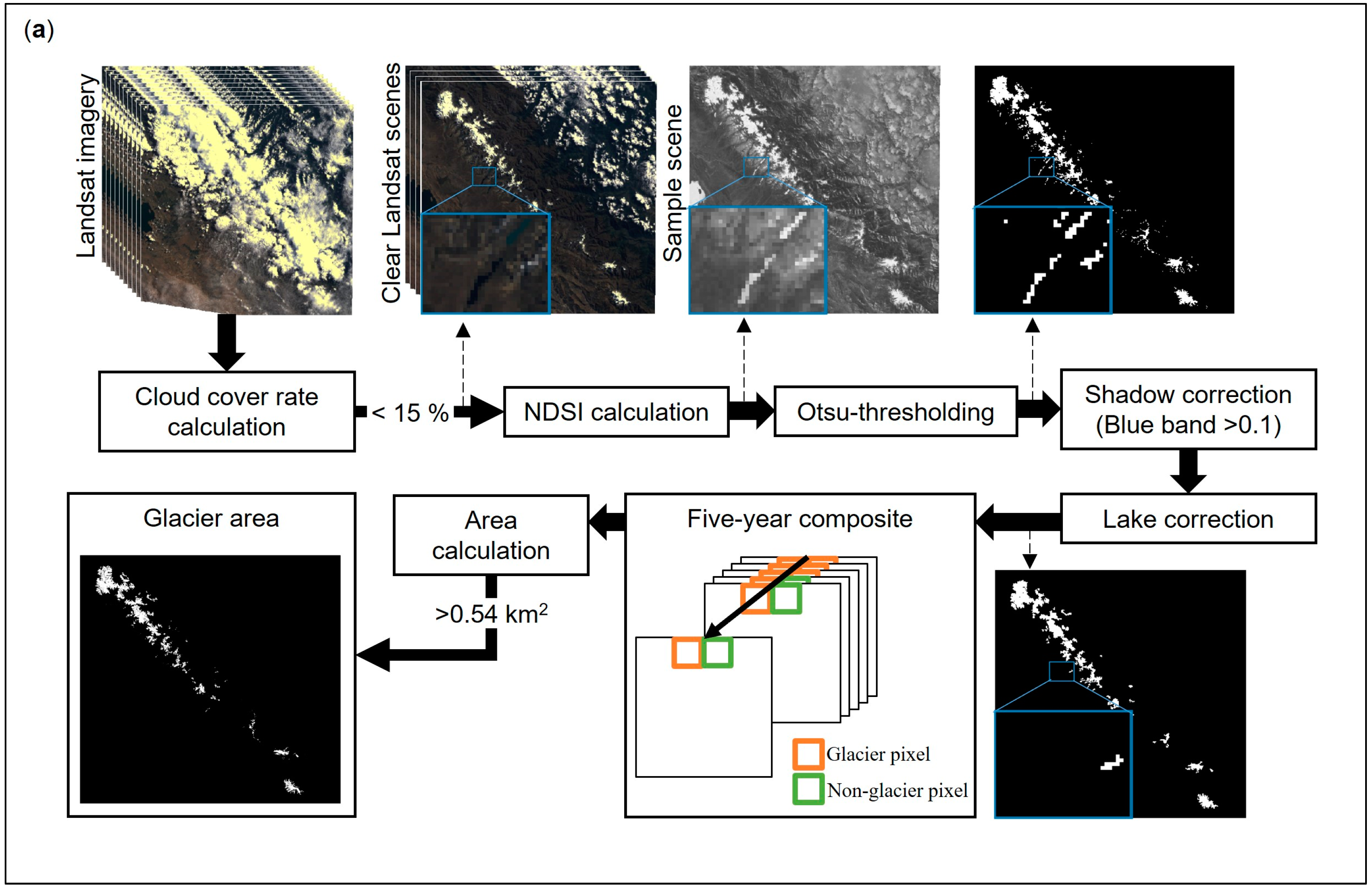
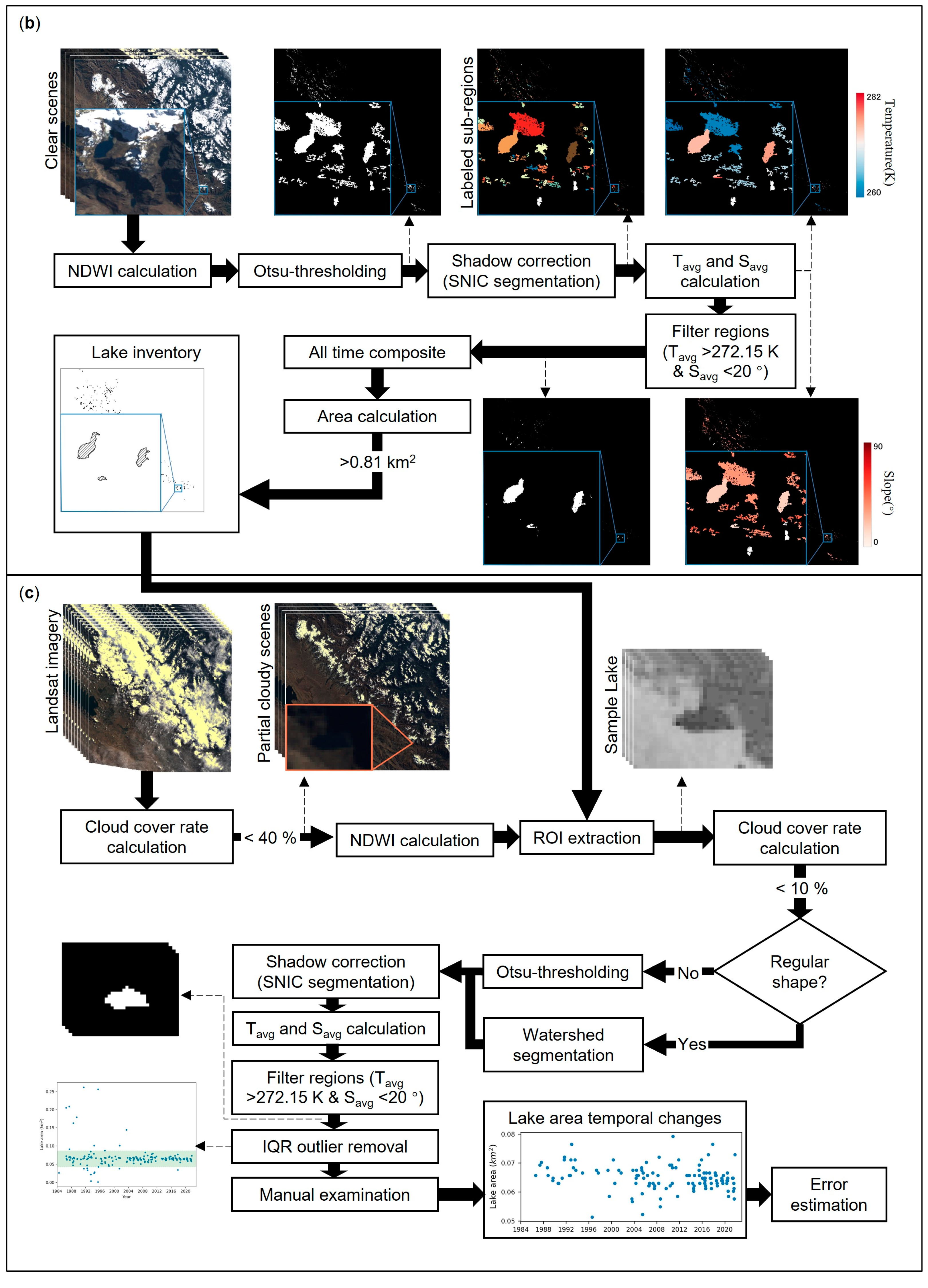

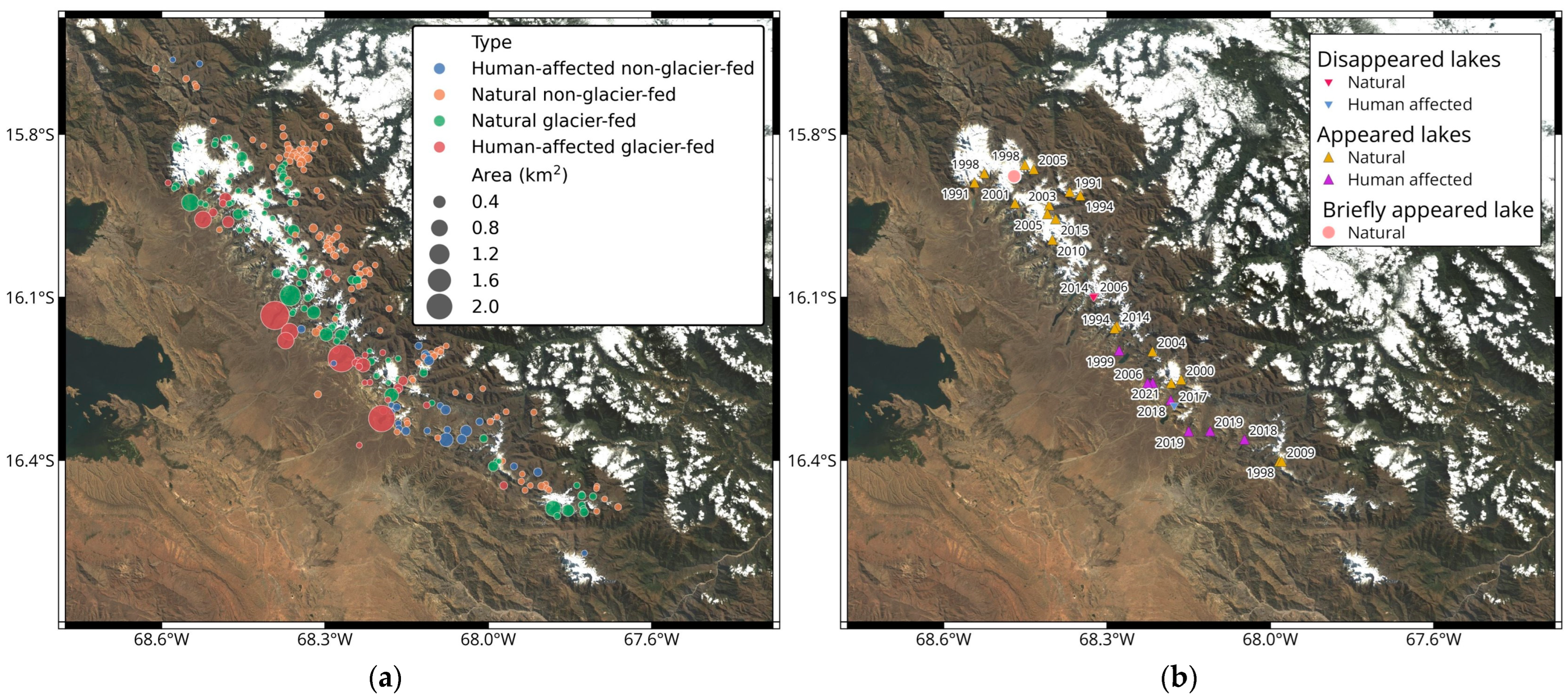


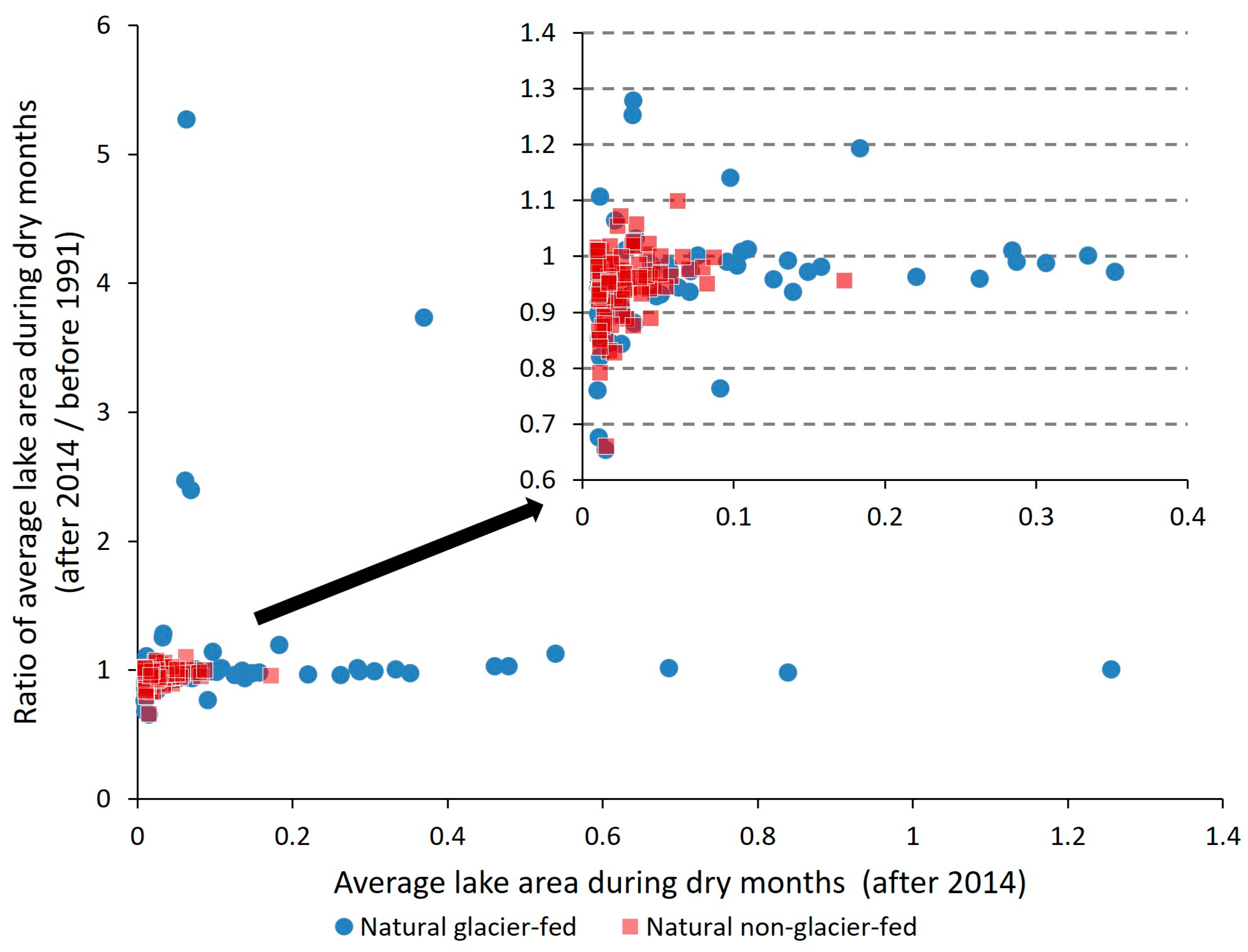
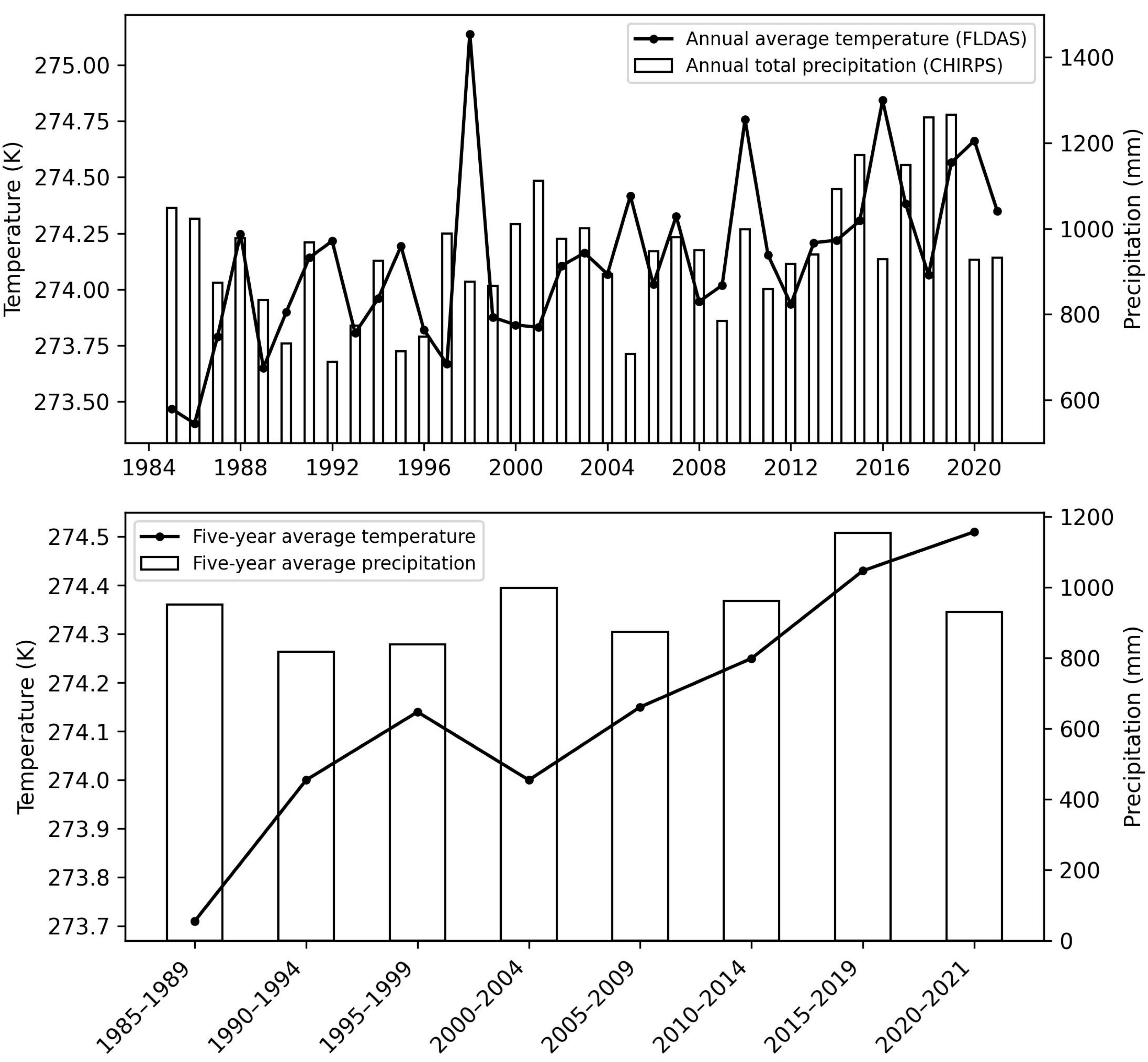
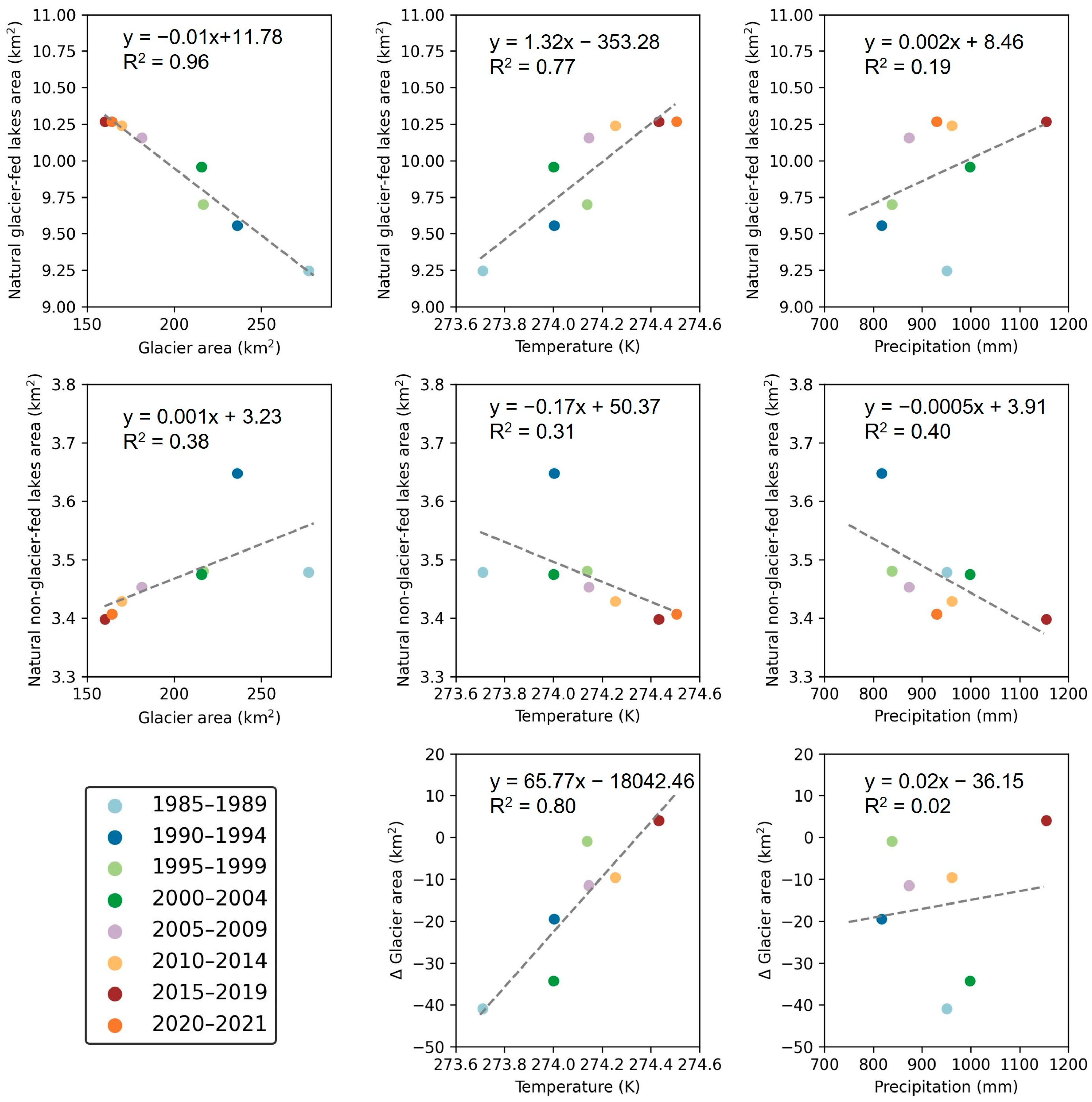
| Full Name | Abbreviate | Temporal Domain | Temporal Resolution | Spatial Resolution | Institutional Sources | Purpose | Reference | Data Access |
|---|---|---|---|---|---|---|---|---|
| Landsat 5 TM Collection 2 Tier 1 TOA Reflectance | Landsat 5 | 1984–2011 | - | 30 m | USGS/Google | Glacier and glacial lake mapping | - | https://developers.google.com/earth-engine/datasets/catalog/LANDSAT_LT05_C02_T1_TOA, accessed on 1 June 2022 |
| Landsat 8 Collection 2 Tier 1 TOA Reflectance | Landsat 8 | 2013–present | - | 30 m | USGS/Google | Glacier and glacial lake mapping | - | https://developers.google.com/earth-engine/datasets/catalog/LANDSAT_LC08_C02_T1_TOA, accessed on 1 June 2022 |
| Shuttle Radar Topography Mission (SRTM) digital elevation data V3 product (SRTM Plus) | SRTM DEM | 2000 | - | 1 arc-second (approximately 30m) | NASA/USGS/JPL-Caltech | Generate slope map, catchment calculation | [35] | https://developers.google.com/earth-engine/datasets/catalog/USGS_SRTMGL1_003, accessed on 1 June 2022 |
| Global Land Ice Measurements From Space | GLIMS | 1999–2000 | - | - | National Snow and Ice Data Center (NSDIC) | Sample data for calculating global Otsu-threshold in glacier delineation, reference data for determining whether a catchment receives glacier melting water | [30] | https://developers.google.com/earth-engine/datasets/catalog/GLIMS_current, accessed on 1 June 2022 |
| SRTM water body data | SRTM WBD | 2000 | - | lakes greater than 600 m × 183 m | National Geospatial-Intelligence Agency (NGA) | Sample data for calculating global Otsu-threshold in lake delineation | - | https://earthexplorer.usgs.gov/, accessed on 28 April 2022 |
| Sentinel-2 MSI: MultiSpectral Instrument, Level-1C | Sentinel-2 | 2015–present | - | 10 m | The Copernicus Open Access Hub | Validation datasets for lake delineation result | - | https://dataspace.copernicus.eu/explore-data/data-collections/sentinel-data/sentinel-2, accessed on 19 June 2023 |
| Average temperature at El Alto International Airport | - | 1984–2021 | Daily | - | National Climate Data Center (NCDC) | Validation datasets for monthly average temperature | - | https://www.ncei.noaa.gov/cdo-web/, accessed on 6 March 2023 |
| Monthly total precipitation observed at eight locations | - | 2011–2017 | Monthly | - | GRANDE/JSPS Bilateral Joint Research | Validation datasets for monthly total precipitation | [8] | Data is not accessible for open use. http://grande.civil.tohoku.ac.jp/index_e.html, accessed on 12 June 2023 |
Disclaimer/Publisher’s Note: The statements, opinions and data contained in all publications are solely those of the individual author(s) and contributor(s) and not of MDPI and/or the editor(s). MDPI and/or the editor(s) disclaim responsibility for any injury to people or property resulting from any ideas, methods, instructions or products referred to in the content. |
© 2024 by the authors. Licensee MDPI, Basel, Switzerland. This article is an open access article distributed under the terms and conditions of the Creative Commons Attribution (CC BY) license (https://creativecommons.org/licenses/by/4.0/).
Share and Cite
Huang, Y.; Kinouchi, T. Revealing Decadal Glacial Changes and Lake Evolution in the Cordillera Real, Bolivia: A Semi-Automated Landsat Imagery Analysis. Remote Sens. 2024, 16, 1231. https://doi.org/10.3390/rs16071231
Huang Y, Kinouchi T. Revealing Decadal Glacial Changes and Lake Evolution in the Cordillera Real, Bolivia: A Semi-Automated Landsat Imagery Analysis. Remote Sensing. 2024; 16(7):1231. https://doi.org/10.3390/rs16071231
Chicago/Turabian StyleHuang, Yilin, and Tsuyoshi Kinouchi. 2024. "Revealing Decadal Glacial Changes and Lake Evolution in the Cordillera Real, Bolivia: A Semi-Automated Landsat Imagery Analysis" Remote Sensing 16, no. 7: 1231. https://doi.org/10.3390/rs16071231
APA StyleHuang, Y., & Kinouchi, T. (2024). Revealing Decadal Glacial Changes and Lake Evolution in the Cordillera Real, Bolivia: A Semi-Automated Landsat Imagery Analysis. Remote Sensing, 16(7), 1231. https://doi.org/10.3390/rs16071231






